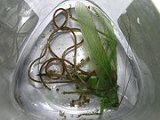
Mermithidae
Encyclopedia
Mermithidae is a family of nematode
worms that are endoparasites in arthropods. As early as 1877, Mermithidae was listed as one of nine subdivisions of the Nematoidea. Mermithidae are confusable with the horsehair worms of the phylum Nematomorpha
that have a similar life history and appearance.
Mermithids are parasites, mainly of arthropods. Most are known from insects, but some are recorded from spiders, scorpions and crustaceans. A few are known to parasitize earthworms, leeches and molluscs, and a specimen is known from a spider preserved in forty million-year old Baltic amber. At least 25 species are known to parasitize mosquito larvae, making them of considerable interest in biological control.
with layers of spiral fibres. The digestive tract is similar to that of free-living nematodes only in the young larvae prior to their parasitic life; in the parasitic stages the oesophagus is disconnected from the mid-intestine, and females lack an anus. The female genital opening is at the midbody, while the male opening is at the tip and visible as one or two spicules. The eggs are laid either in water or on land, and the newly hatched larvae are free-living, as are the adults that emerge from the hosts to lay eggs.
The taxonomy of the group has been confused due to poor specimen collection as well as very limited morphological characteristics, and most are discovered by entomologists rather than nematologists. Even the best-studied species, Romanomermis culicivorax, has an unclear taxonomic status.
Nematode
The nematodes or roundworms are the most diverse phylum of pseudocoelomates, and one of the most diverse of all animals. Nematode species are very difficult to distinguish; over 28,000 have been described, of which over 16,000 are parasitic. It has been estimated that the total number of nematode...
worms that are endoparasites in arthropods. As early as 1877, Mermithidae was listed as one of nine subdivisions of the Nematoidea. Mermithidae are confusable with the horsehair worms of the phylum Nematomorpha
Nematomorpha
Nematomorpha is a phylum of parasitic animals that are superficially morphologically similar to nematode worms, hence the name. They range in size in most species from long and can reach in extreme cases up to 2 metres, and in diameter...
that have a similar life history and appearance.
Mermithids are parasites, mainly of arthropods. Most are known from insects, but some are recorded from spiders, scorpions and crustaceans. A few are known to parasitize earthworms, leeches and molluscs, and a specimen is known from a spider preserved in forty million-year old Baltic amber. At least 25 species are known to parasitize mosquito larvae, making them of considerable interest in biological control.
Life history
Mermithids are wire-like and have a smooth cuticleCuticle
A cuticle , or cuticula, is a term used for any of a variety of tough but flexible, non-mineral outer coverings of an organism, or parts of an organism, that provide protection. Various types of "cuticles" are non-homologous; differing in their origin, structure, function, and chemical composition...
with layers of spiral fibres. The digestive tract is similar to that of free-living nematodes only in the young larvae prior to their parasitic life; in the parasitic stages the oesophagus is disconnected from the mid-intestine, and females lack an anus. The female genital opening is at the midbody, while the male opening is at the tip and visible as one or two spicules. The eggs are laid either in water or on land, and the newly hatched larvae are free-living, as are the adults that emerge from the hosts to lay eggs.
The taxonomy of the group has been confused due to poor specimen collection as well as very limited morphological characteristics, and most are discovered by entomologists rather than nematologists. Even the best-studied species, Romanomermis culicivorax, has an unclear taxonomic status.
External links
- Biological control potential
- http://flnem.ifas.ufl.edu/HISTORY/entomophilic_history.htm
- http://www.uel.ac.uk/mosquito/issue10/mermithids.htm
- Mermis nigrescens on the UF / IFASInstitute of Food and Agricultural SciencesThe University of Florida’s Institute of Food and Agricultural Sciences is a federal-state-county partnership dedicated to developing knowledge in agriculture, human and natural resources, and the life sciences, and enhancing and sustaining the quality of human life by making that information...
Featured Creatures Web site

